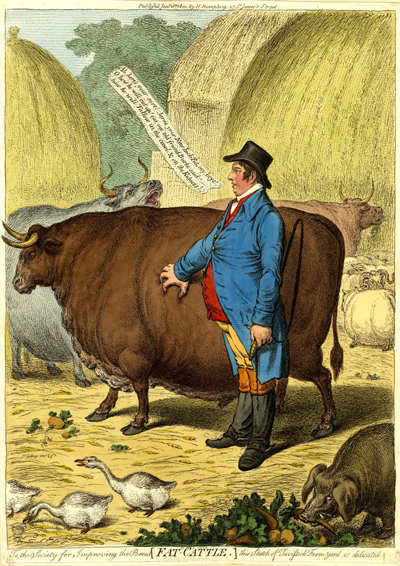Fat Cattle
"Fat" is the operative word here: fat round stacks of hay, enormously fat cattle, fat sheep, fat geese, a fat pig, and, of course, the fat Duke of Bedford whose jacket is straining to contain his more than ample belly.

© Trustees of the British Museum
Besides being one of the richest men in England, and a major spokeperson for the Whigs in the House of Lords, the 5th Duke of Bedford was a dedicated experimenter in farming and animal breeding at his estates at Woburn Abbey and Tavistock. He was a member of the original Board of Agriculture, and the first President of the Smithfield Cattle and Sheep Society in 1798 which continues to this day as the Royal Smithfield Club, dedicated then as now to "the maintenance and improvement of livestock quality."
Bedford's depiction with a prime example of his cattle consequently seems very much in keeping with portrait caricature where the subject is identified by surrounding details. His speech, brimming over with pride in the results of his improvements to the breed, also seems to be completely consistent with a portrait caricature.
Ah, here's your sort! - here's your Nine-Inch Fat my boys! "O how he will cut up! (as my old friend Burke said!) - "how he will Tallow in the cawl and on the Kidneys!"
But, as Nicholas K. Robinson points out, the reference to "my old friend Burke" gives the print a decidedly more satiric turn. The lines derive from Edmund Burke's A Letter to a Noble Lord (1796), addressed to Bedford, where Burke talks about the distinctions which give Bedford his position in society and which would be erased if the French revolution came to England. The French sans-culottes
will no more regard a Marquis of Tavistock than an Abbot of Tavistock; the Lord of Woburn will not be more respectable in their eyes than the Prior of Woburn; they will make no difference between the superior of a Covent Garden of nuns, and of a Covent Garden of another description. They will not care a rush whether his coat is long or short; whether the colour be purple or blue and buff. They will not trouble their heads, with what part of his head his hair is cut from; and they will look with equal respect on a tonsure and a crop. Their only question will be that of their Legendre, or some other of their legislative butchers, how he cuts up? how he tallows in the cawl, or on the kidneys?
Burke (and Gillray) find it extremely ironic that while Bedford and his Whig compatriots are fawning over the French philosophes in Parliamentary speeches,
the sans-cullote carcass-butchers, and the philosophers of the shambles, are pricking their dotted lines upon his hide, and, like the print of the poor ox that we see in the shop-windows at Charing Cross, alive as he is, and thinking no harm in the world, he is [being] divided into rumps, and sirloins, and briskets, into all sorts of pieces for roasting, boiling, and stewing.
The title, Fat Cattle, then, refers to Bedford as well as his livestock, and both are marked for slaughter.
NOTE: The 5th Duke of Bedford died about six weeks after this print appeared on March 2, 1802 from what appears to have been a strangulated hernia.
Sources and Reading
- Commentary from the British Museum on Fat Cattle.
- Draper Hill, The Satirical Etchings of James Gillray, 1976, #74.
- Nicholas K Robinson, Edmund Burke: A Life in Caricature, 1996, p. 187.
- "Francis Russell, 5th Duke of Bedford," Wikipedia
- "History," The Royal Smithfield Club
- "Board of Agriculture (1793-1822)," Wikipedia
- "A Letter to a Noble Lord," Wikisource
- Thomas Wright and R.H. Evans, Historical and Descriptive Account of the Caricatures of James Gillray #503.
- Thomas Wright and Joseph Grego, The Works of James Gillray, the Caricaturist; With the History of His Life and Times, p. 290.
Comments & Corrections
NOTE: Comments and/or corrections are always appreciated. To make that easier, I have included a form below that you can use. I promise never to share any of the info provided without your express permission.